The following papers may be downloaded free,
for personal use only.
“Isaac
Newton and the astronomical refraction” Lehn 2008
Abstract: In a short interval toward the end of 1694, Isaac
Newton developed two mathematical models for the theory of the
astronomical refraction and calculated two refraction tables,
but did not publish his theory. Much effort has been expended,
starting with Biot in 1836, in
the attempt to identify the methods and equations that Newton
used. In contrast to previous work, a closed form solution is
identified for the refraction integral that reproduces the
table for his first model (in which density decays linearly
with elevation). The parameters of his
second model, which includes the exponential variation of
pressure in an isothermal atmosphere, have also been
identified by reproducing his results. The
implication is clear that in each case Newton had derived
exactly the correct equations for the astronomical refraction;
furthermore, he was the first to do so.
Download
full paper (390
KB)
“Atmospheric refraction: a history”
Lehn, van der Werf 2005
Abstract: We trace the history of atmospheric refraction
from the ancient Greeks up to the time of Kepler. The concept that the
atmosphere could refract light entered Western science in the
second century B.C. Ptolemy, 300 years later, produced the
first clearly defined atmospheric model, containing air of
uniform density up to a sharp upper transition to the ether,
at which the refraction occurred. Alhazen
and Witelo transmitted his
knowledge to medieval Europe. The first
accurate measurements were made by Tycho
Brahe in the 16th century. Finally, Kepler, who was aware of unusually
strong refractions, used the Ptolemaic model to explain the
first documented and recognized mirage (the Novaya Zemlya
effect).
Download
full paper (930
KB)
“The hafstramb
and margygr of the King’s
Mirror: an analysis” Lehn,
Schroeder 2004
Abstract: Greenland and Iceland are described with unusual
scientific accuracy in the King’s Mirror. However this
thirteenth-century manuscript contains a few ‘wonders’ that
appear more mythological than rational. They include the hafstramb and the margygr, commonly translated
respectively as merman and mermaid. The mermaid has a long
history in western civilisation.
The commonly accepted theory that it evolved from the
classical Greek siren is critically examined here. The margygr is shown to be a
distinct creature based on independent observation in northern
Europe. The characteristics of these observations actually
modified the siren of the Physiologus,
a bird-woman, into the fish-woman known today. Observations of
hafstramb and margygr are explained as
superior mirages. These are caused by atmospheric refraction,
which distorts and magnifies distant objects. Computer
simulations and photographs show that mirages of an orca, a
walrus, or even a boulder match almost point for point the
descriptions in the King’s Mirror. Thus the apparently
mythical components in the Greenland account are in fact
careful scientific observations.
Download
full paper (270
KB)
“Hafgerdingar:
a mystery from the King’s Mirror explained” Lehn,
Schroeder 2003
Abstract: The medieval King’s Mirror describes Iceland and
Greenland with a scientific accuracy that is remarkable. One
of the very few exceptions is the hafgerdingar
in the Greenland Sea. The term translates as ‘sea hedges,’
within which a mariner may become trapped at great peril. Many
have believed that a real event was being described, although
none of the proposed explanations has been totally
satisfactory. The most common view currently is based on Steenstrup (1871), who explained the
phenomenon as a tidal wave following a submarine earthquake. A
simpler and more consistent theory is developed here: that the
hafgerdingar are an optical
phenomenon, specifically, a superior mirage. Such mirages,
quite common in the polar regions,
can produce an appearance fully consistent with the original
description, as illustrated by several photographs and a
computer simulation. Even the peril to seafarers has been
corroborated, in the sense that such a mirage is frequently
followed by a storm.
Download
full paper (170
KB)
“Gerrit de Veer’s true and perfect
description of the Novaya Zemlya effect, 24 –27 January 1597”
van der Werf, Können, Lehn, Steenhuisen,
Davidson 2003
Abstract: The first recordings of the Novaya Zemlya NZ
effect were made during Willem Barents’ third Arctic
expedition. Ray-tracing analyses of the three key
observations, on 24 –27 January 1597, show that all the
reported details can be explained by adopting one common and
realistic type of temperature inversion. In particular, the
Moon–Jupiter conjunction could have been visible over the
central mountain ridge of the island. We show that the NZ
effect distorts the relative positions of Jupiter and the Moon
in such a way that the looked-for fingerprint of the
conjunction occurred almost 2 h after the true conjunction.
The quoted direction for the apparent Moon–Jupiter conjunction
is then found to be accurate to within 1°. This delay of the
apparent conjunction largely explains the error of 29° in
their longitude determination. The truthfulness of these
observations, debated for four centuries, now appears to be
beyond doubt.
Download
full paper (1.1
MB)
“Novaya
Zemlya effect and sunsets” van
der Werf, Können,
Lehn 2003
Abstract: Systematics of the Novaya Zemlya NZ effect are discussed in the context of
sunsets. We distinguish full mirages, exhibiting oscillatory
light paths and their onsets, the subcritical mirages.
Ray-tracing examples and sequences of solar images are shown.
We discuss two historical observations by Fridtjof Nansen and by Vivian Fuchs,
and we report a recent South Pole observation of the NZ effect
for the Moon.
Download
full paper (2
MB)
“Bright superior mirages” Lehn 2003
Abstract: Superior mirages of unusual brightness are
occasionally observed. Two such cases, photographed over the
frozen surface of Lake Winnipeg, Canada, are documented.
Visually, these mirages appear as featureless bright barriers
far out on the lake. They are just images of the lake ice, yet
the luminance in one case was 2.5 times in the other, 1.7 times the
luminance of the ice surface in front of the mirage. The
mirage itself can be modeled by means of a conduction
inversion, but a proper explanation of the brightness is not
yet available.
Download
full paper (760
KB)
Photographs appearing in the paper are available in full resolution:
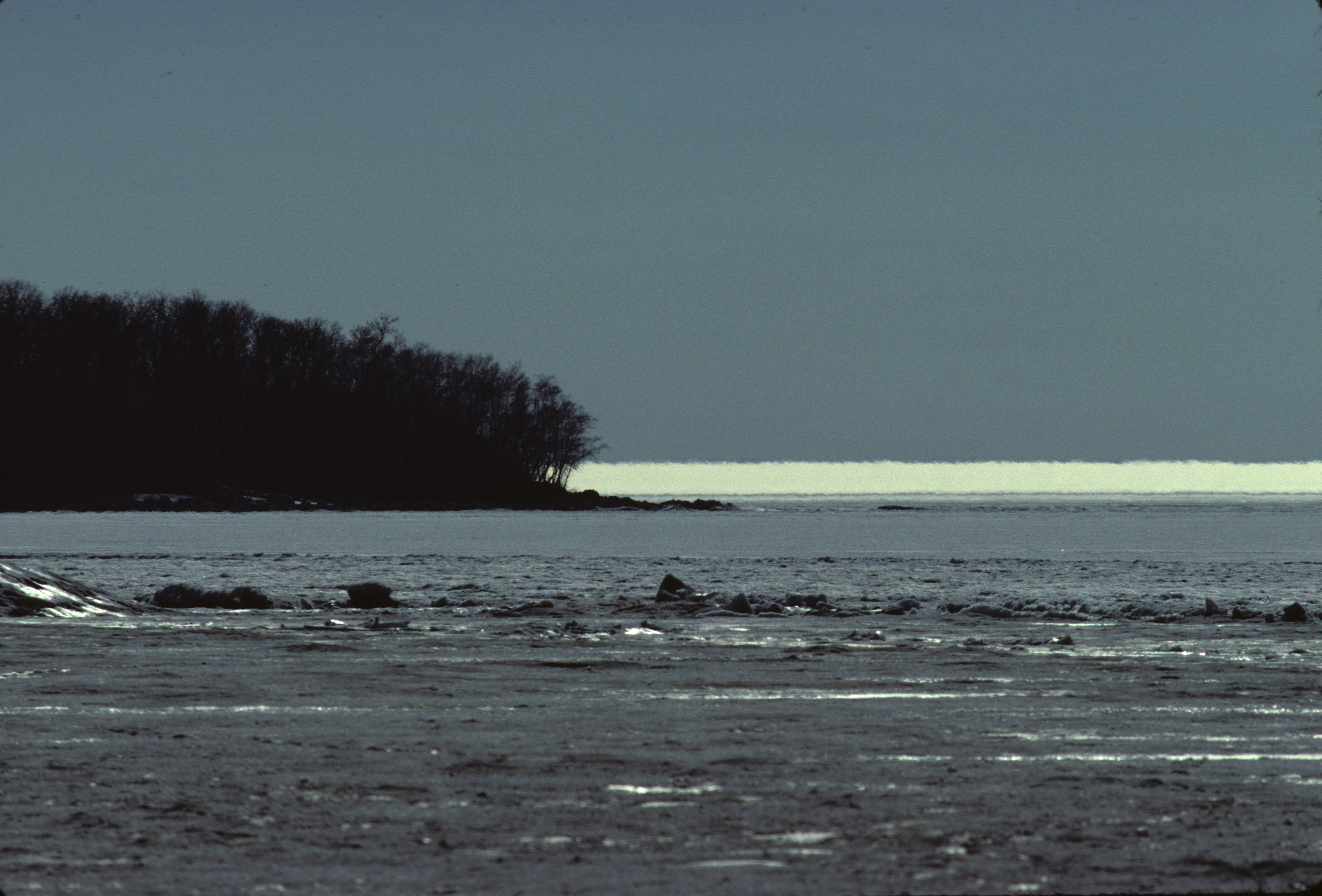
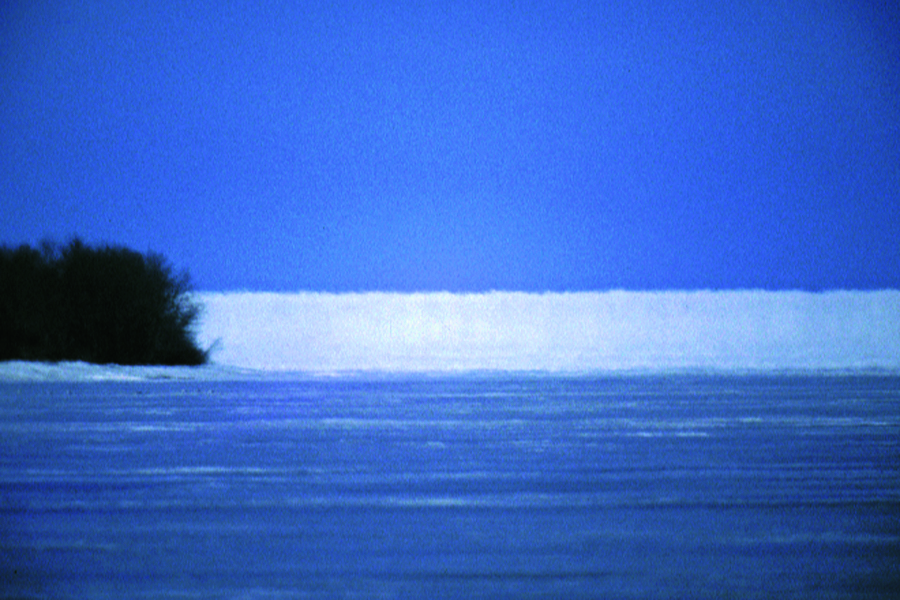
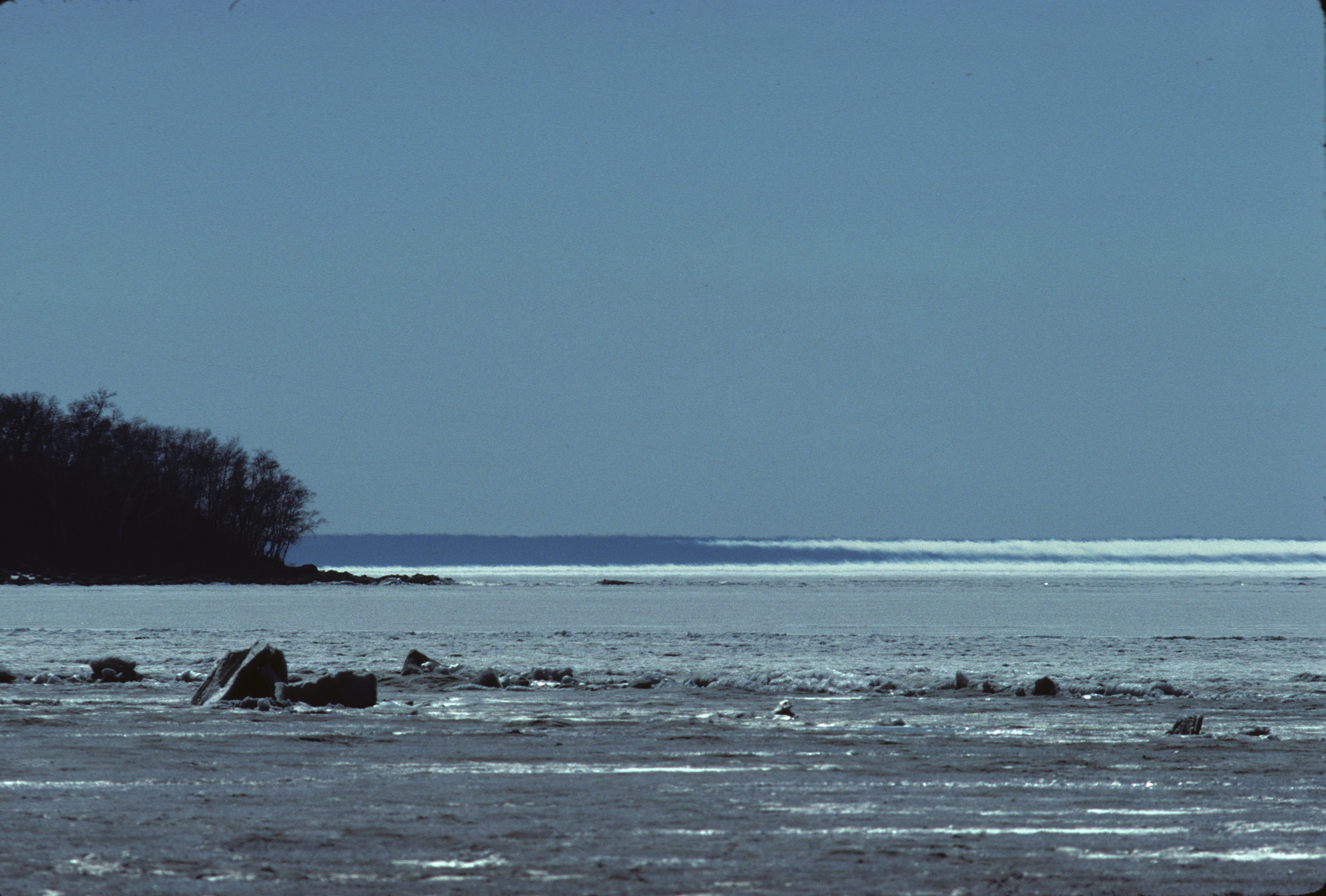
“Exact temperature profile for the hillingar mirage”
Lehn
2001
Abstract: In a hillingar
mirage, the Earth’s surface appears flat, because nearly
horizontal light rays have the same curvature as the Earth. A
linear temperature profile is traditionally inferred; its
gradient is calculated to give this curvature to the exact
horizontal ray. To see an image, however, a bundle of rays is required. To ensure that each ray in
the bundle have the same
curvature, the temperature profile must contain a small
positive quadratic term, the coefficient of which is derived.
Download
full paper (810
KB)
“Skerrylike mirages and the discovery
of Greenland” Lehn 2000
Abstract: The Norse discovery of Greenland is associated
with the sighting of low barren islands called Gunnbjörn’s Skerries,
which have never been satisfactorily identified. Here the
historical references that connect the skerries
to Greenland are reviewed. A mirage of the Greenland coast,
arising specifically from optical ducting under a sharp
temperature inversion, is used to explain the vision of skerries seen by the Norse mariners.
Images from both ducting and uniform inversions are
calculated. Under the assumption of a clean Rayleigh
atmosphere, sufficient visibility remains to see the skerry image at a distance of 220 km.
There is significant circumstantial evidence to indicate that
the Norse were familiar with the skerrylike mirage and that they used
it to discover new lands.
Download
full paper (740
KB)
“Long-range
superior mirages” Lehn,
Legal 1998
Abstract: Superior mirages of simple appearance are
occasionally observed over distances exceeding 70 km. These
mirages cannot be explained in terms of standard textbook
models; rather, they are shown to arise from fairly complex
atmospheres. Two observations of different types, observed at
Resolute Bay, Canada, are presented. The first is the basic
three-image mirage in which one inverted and one erect image
float above the object. The second is a single-image mirage in
which the object is elevated but undistorted. For each, the
most suitable atmospheric model contains several distinct
atmospheres, and the first one requires sloped atmospheric
layers as well.
Download
full paper (710
KB)
Photographs appearing in the paper
are available in full resolution:
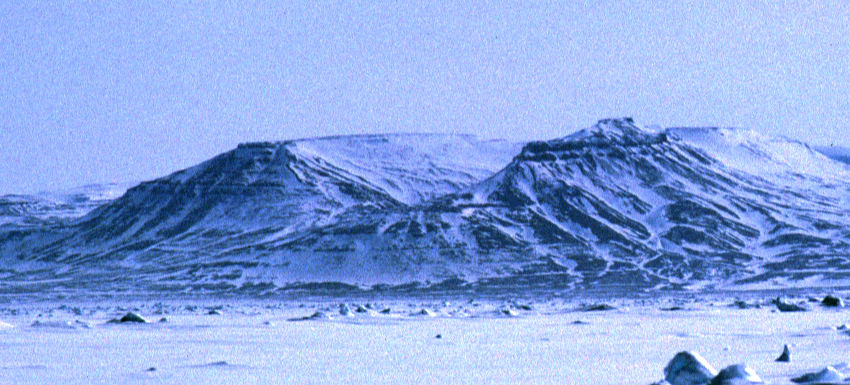
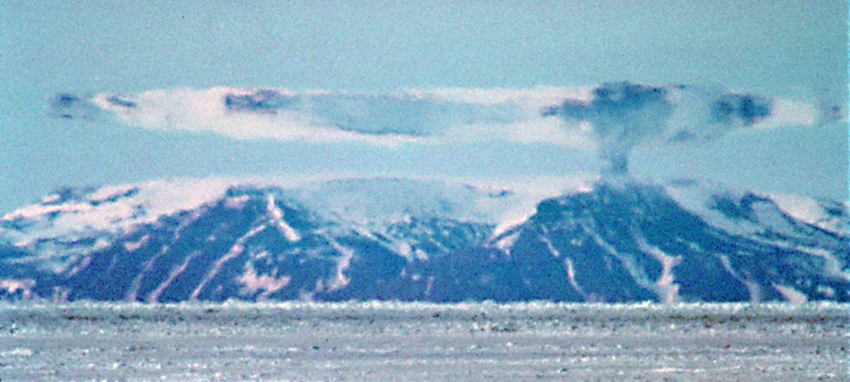
“Analysis
of an infrared mirage sequence” Lehn 1997
Abstract: Infrared observations of seaborne thermal sources
are subject to the effects of atmospheric refraction. For low
elevation angles at long ranges, out to the limit of
visibility, the inevitable atmospheric temperature gradients
frequently produce mirages. I present an analysis of a 22-min
sequence of images recorded on 18 February 1994 at the U.S.
Naval Surface Warfare Center at Wallops Island, Virginia. The
infrared target is a heat source carried on a ship moving in a
straight line toward the camera. The images show a
quasi-periodic variation of the horizon elevation, as well as
an extended range of visibility. A model that reasonably
reproduces the observed features consists of a small
temperature inversion in a slightly sloped atmosphere, with an
atmospheric gravity wave moving across the line of sight.
Download
full paper (1
MB)
“Mirages with atmospheric gravity waves”
Lehn, Silvester,
Fraser 1994
Abstract: The temperature inversions that produce
superior mirages are capable of supporting gravity (buoyancy)
waves of very low frequency and long wavelength. This paper
describes the optics of single mode gravity waves that
propagate in a four-layer atmosphere. Images calculated by ray
tracing show that (1) relatively short waves add a fine
structure to the basic static mirage, and (2) long waves
produce cyclic images, similar to those observed in the field,
that display significant variation from a base image.
Download
full paper (1.4
MB)
Photographs appearing in the paper
are available in full resolution:




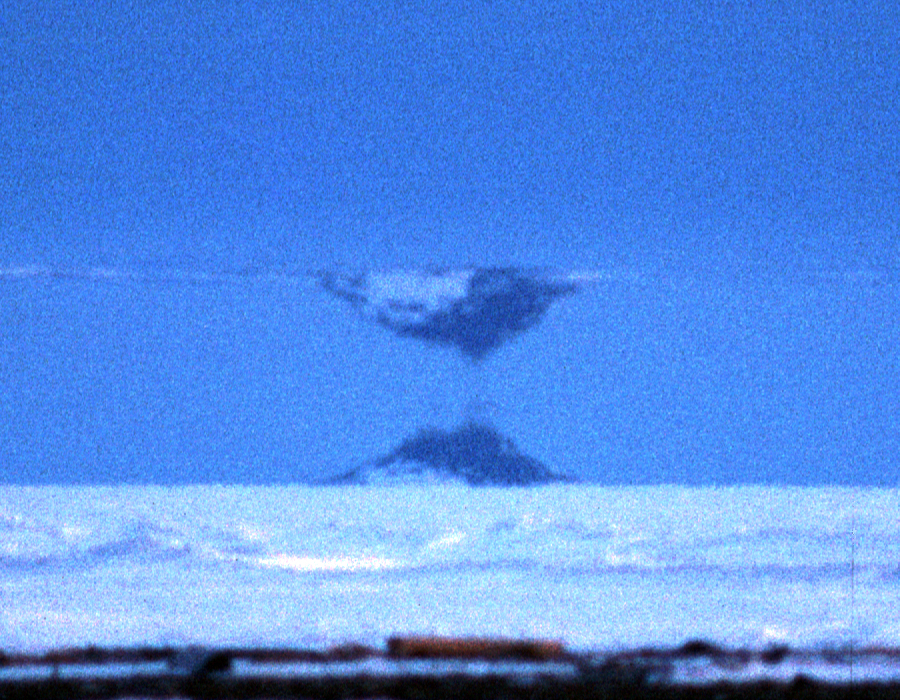
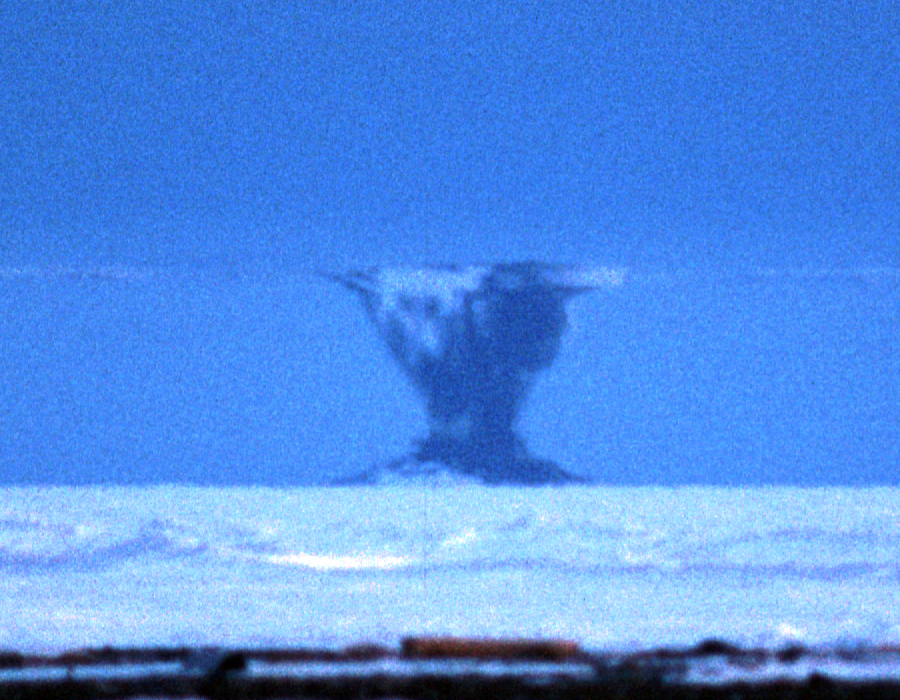
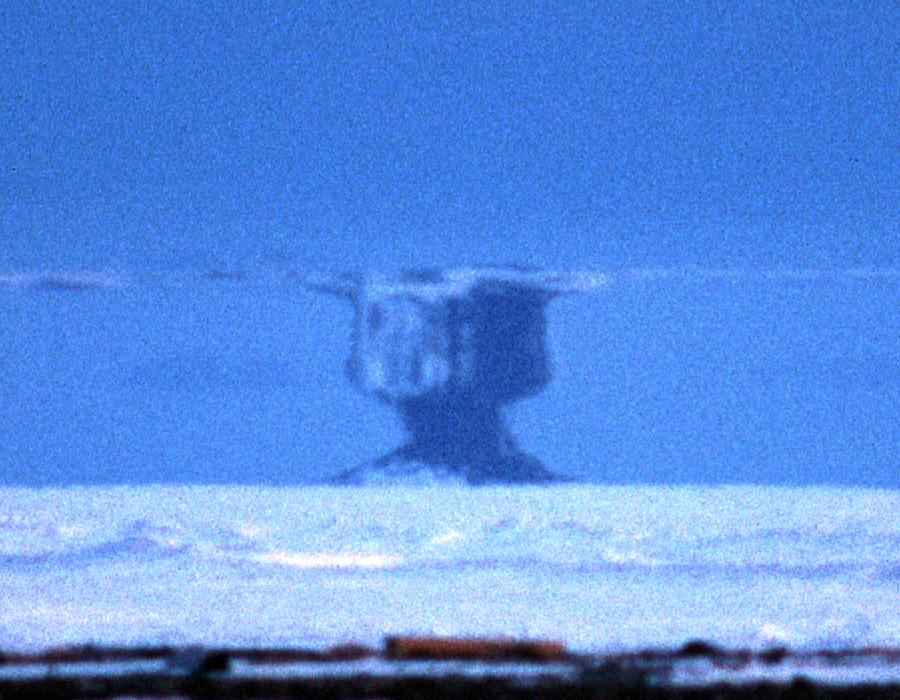

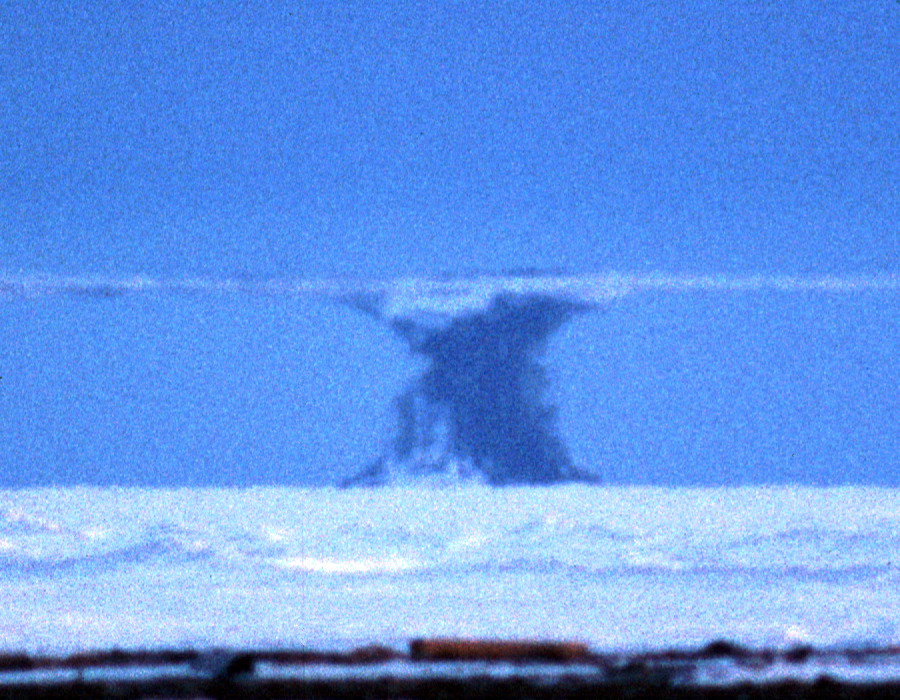
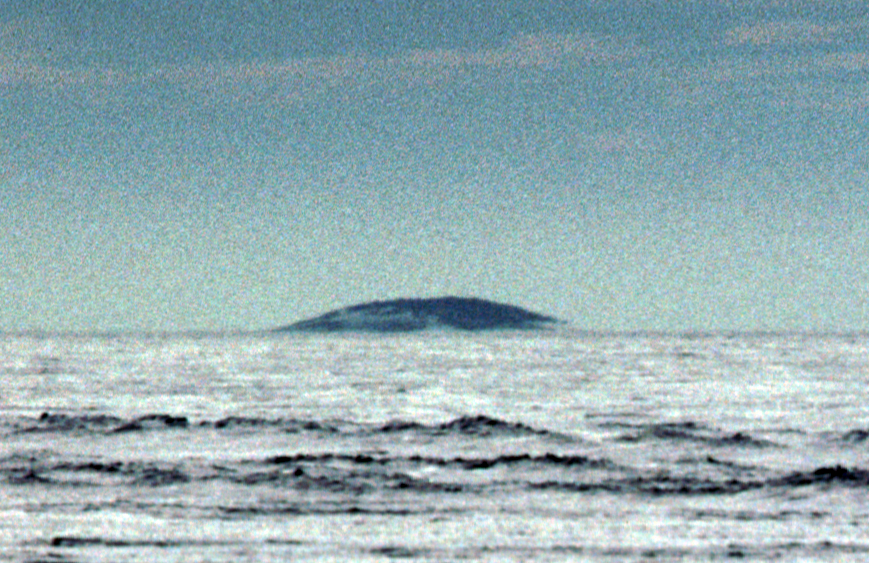
Fig. 1a
Fig. 1b Fig. 1c Fig. 1d Fig. 1e Fig. 1f Fig. 1g Fig. 1h Fig. 1i Fig. 2
“Differential
geometric approach to atmospheric refraction”
Kropla, Lehn 1992
Abstract: Differential geometric techniques are presented
and used to model the optical properties of the atmosphere
under conditions that produce superior mirages. Optical path
length replaces the usual Euclidean metric as a
distance-measuring function and is used to construct a surface
on which the paths of light rays are geodesics. The geodesic
equations are shown to be equivalent to the ray equation in
the plane. A differential equation that relates the Gaussian
curvature of the surface and the refractive index of the
atmosphere is derived. This equation is solved for the cases
in which the curvature vanishes or is constant. Illustrative observation demonstrate the use of
geometric techniques in the analysis of mirage images.
Download
full paper (1.4
MB)
“Simulation
of mirages”
Lehn, Friesen
1992
Abstract: A mirage is seen when atmospheric refraction
distorts or displaces an image. We describe a mirage simulator
that uses digital imaging equipment to generate mirage images
from normal photographs. The simulation program relocates horizonal image lines into positions
that they appear to occupy, according to rays traced from
observer to object. Image-brightness adjustments are not
required; we show that, while the atmosphere can change the
size or shape of an object, it does not change its apparent
brightness. The realistic quality of the computed images makes
this simulator a useful tool in mirage analysis.
Download
full paper (1.5
MB)
Photographs appearing in the paper
are available in full resolution:





Fig.
2a
Fig. 2b
Fig. 5a
Fig. 5b
Fig. 5c
“The
Scoresby ship mirage of 1822” Lehn,
Rees 1990
Abstract: A very clear mirage observed by Scoresby in the
Greenland Sea shows an inverted ship floating above the
horizon. This mirage can be mathematically reconstructed using
a linear image diagram. Scoresby’s description is here
re-examined: a new set of essential assumptions is distilled
from his report, and an ‘exact’
reproduction of the mirage is obtained to match these
conditions.
Download
full paper (2
MB)
“A Three-Parameter Inferior Mirage Model for
Optical Sensing of Surface Layer Temperature Profiles”
Lehn, Morrish 1986
Abstract: Inferior mirages provide a sensitive and fairly
accurate probe for determining vertical temperature
distributions in the atmospheric surface layer. Optical
measurements on the image can be used to calculate the
parameters in a temperature profile model, in this case a
function with three adjustable parameters. The function
contains an exponential term (two parameters) and an additive
linear term (one parameter). The optical observations, for
which a known target is required, consist of the elevation
angles of the apparent peak, caustic, and horizon. Analytic
expressions that must be simultaneously satisfied are derived
for all three conditions. The parameter values are extracted
numerically by minimizing a positive definite function of the
three conditions. The model is tested on a set of images for
which nearly simultaneous photographs, theodolite readings,
and temperature profiles were available. For each image the
three calculated elevations matched the measured values very
closely. The complete images also match well in most of the
cases. The results, a distinct improvement over previous
two-parameter models, also provide a more accurate
reconstruction than is obtained from the thermodynamic model
for unstable stratification.
Download
full paper (5.8
MB)
Inversion
of superior mirage data to compute temperature profiles Lehn 1983
Abstract: Information derived from the superior mirage is
used to compute the average vertical temperature profile in
the atmosphere between the observer and a known object. The
image is described by a plot of ray-elevation angle at the eye
against elevation at which that ray intersects the object. The
computational algorithm, based on the tracing of rays that
have at most one vertex, iteratively adjusts the temperature
profile until the observed image characteristics are
reproduced. An example based on an observation made on the
Beaufort Sea illustrates the process.
Download
full paper (940
KB)
Photographs appearing in the paper
are available in full resolution:


“The Norse merman as
an optical phenomenon” Lehn,
Schroeder 1981
Abstract: Mediaeval Norse writings that describe the merman
are considered accurate observations of a natural phenomenon.
Images of common sea mammals, severely distorted by strong,
non-uniform atmospheric refraction, fit the mediaeval
descriptions remarkably well. Three examples are presented:
computer-generated images of a killer whale and a walrus, and
a photograph of a suitably distended boulder. The mediaeval
correlation of a merman sighting with the advent of storms is
also verified.
Download
full paper (2.1
MB)
“Novaya
Zemlya effect: analysis of an observation” Lehn,
German 1981
Abstract: The Novaya Zemlya effect, historically
identified with the premature rebirth of the sun during the
polar night, is a long range
optical ducting phenomenon in the lower atmosphere. An
occurrence of the effect was observed at Tuktoyaktuk,
Canada (69Ż26'N, 133Ż02'W) on 16 May 1979, when the minimum
solar altitude was -1°34'. The sun's image remained above the
horizon, within a gray horizontal band, and assumed the
various expected shapes, ranging from a bright rectangle
filling the band, to three flat suns stacked one over the
other, to several thin vertically separated strips. A model for the corresponding atmospheric
conditions was identified by matching the observations with
images calculated from a computer simulation study.
Download
full paper (1.1
MB)
Photographs appearing in the paper
are available in full resolution:
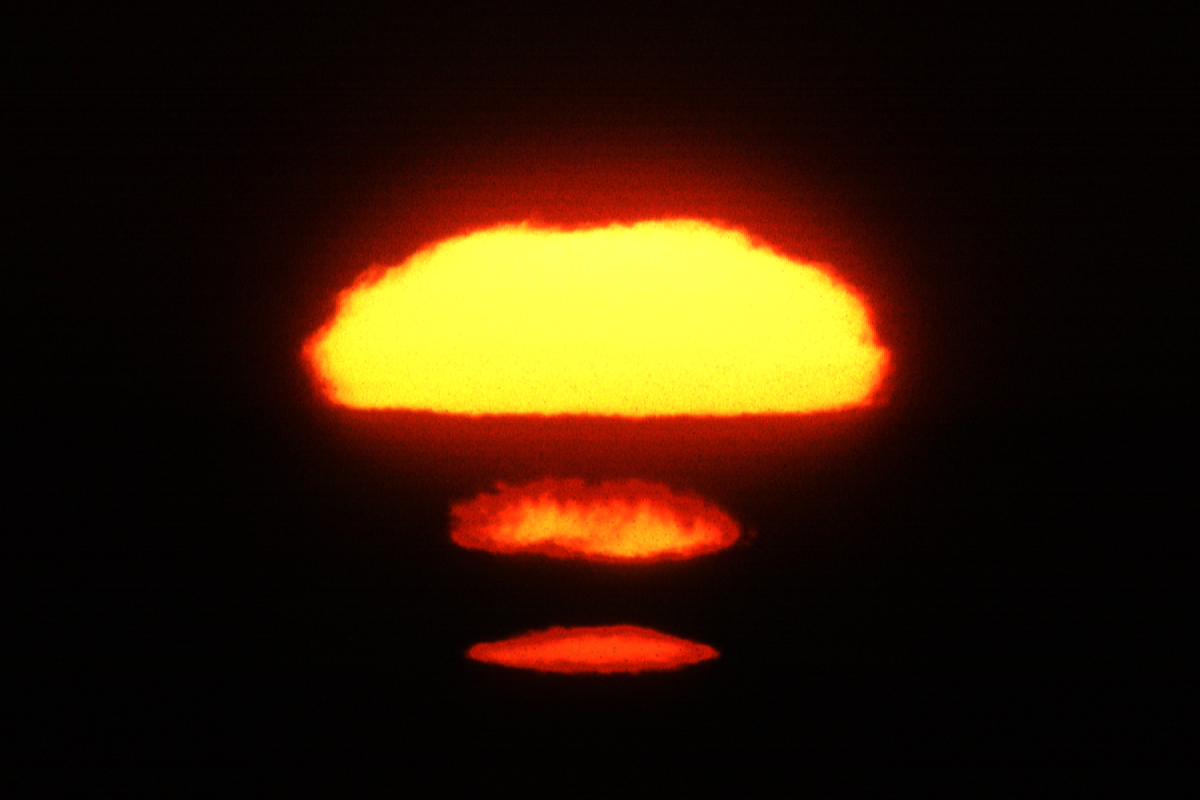
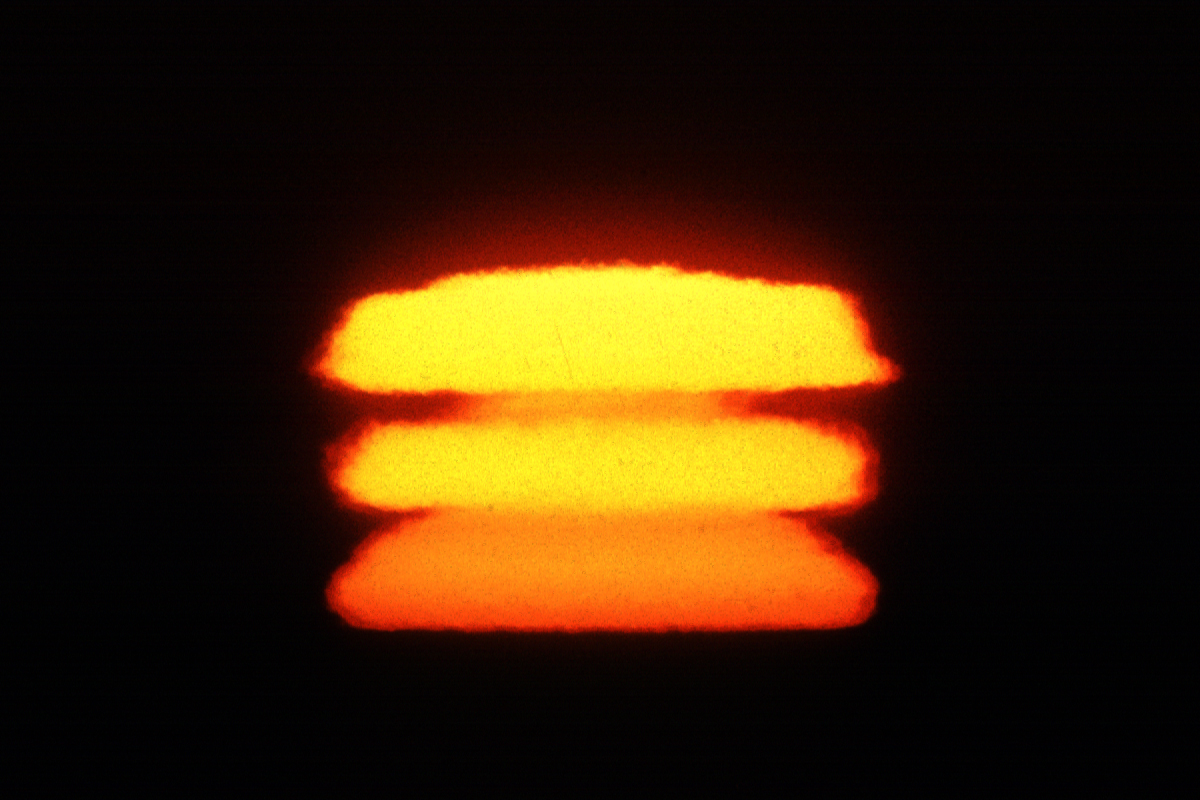

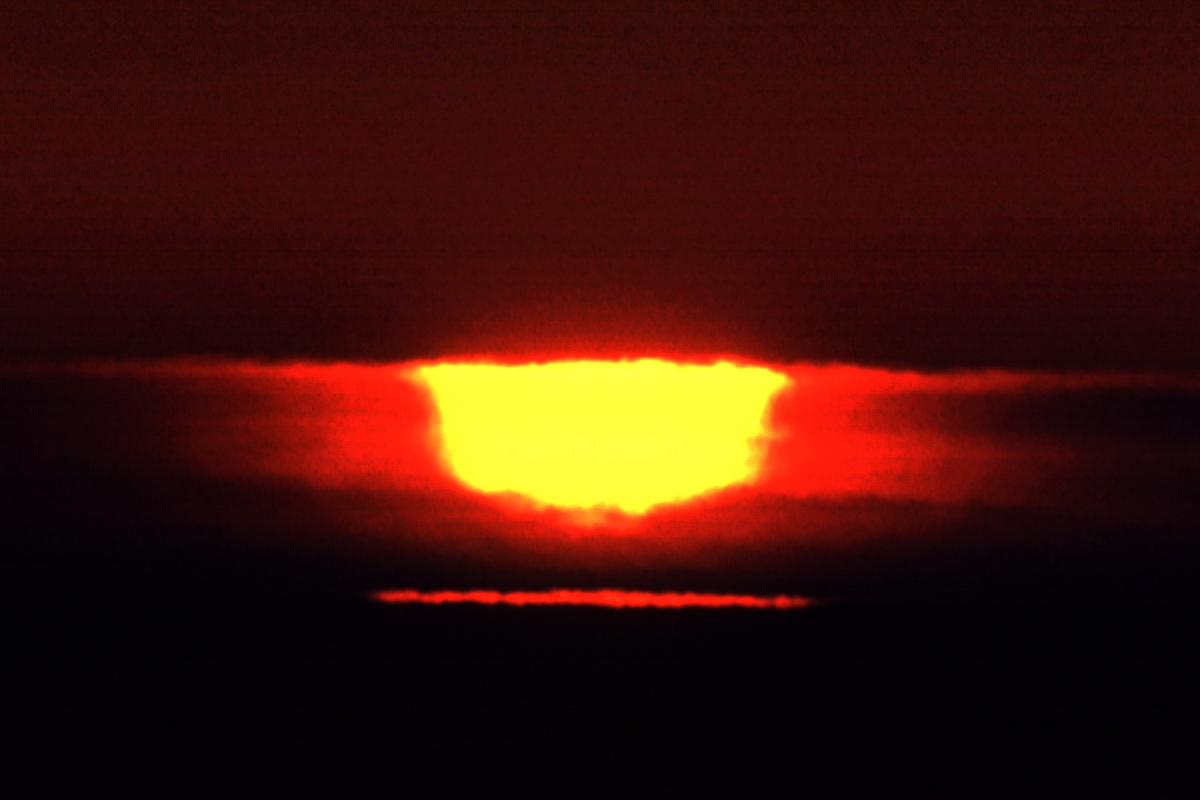
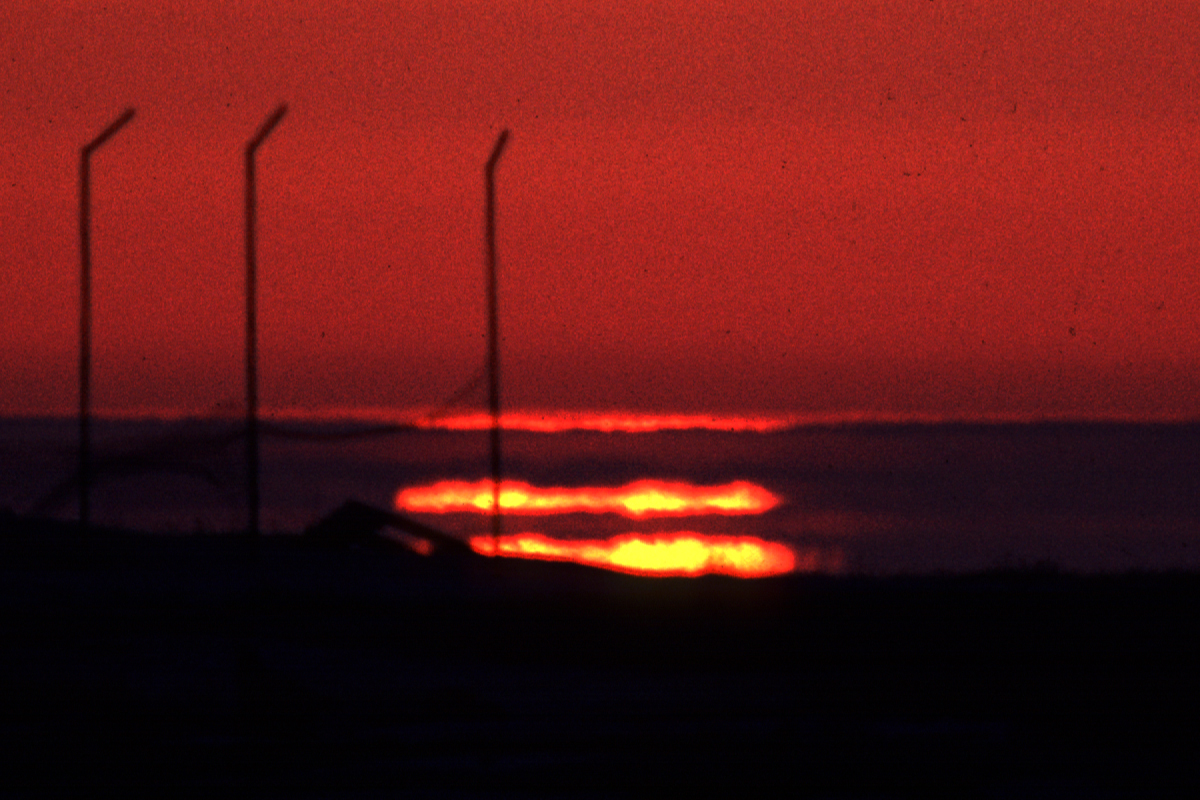
Fig. 4a
Fig. 5a
Fig. 6a
Fig. 8a
Fig. 9
“Polar
Mirages as Aids to Norse Navigation” Lehn,
Schroeder 1979
Abstract: The possibility is examined that the Norse may
have gleaned information from polar mirages for their westward
expansion across the North Atlantic. Two types of superior
mirages, the hillingar and
the Novaya Zemlya effects, are explained briefly. Examples
reported by early explorers are used to familiarize the reader
with the effects and to illustrate both their informative and
confusing natures. Specifically, optical theory is applied in
an attempt to establish the Gunnbjorn Skerries
as images of the Greenland coast, transmitted by mirage across
the Denmark Strait. This hypothesis is supported by an
examination of available historical evidence.
Download
full paper (780
KB)
“The
Novaya Zemlya effect: An arctic mirage” Lehn 1979
Abstract: The arctic mirage is an atmospheric refraction
phenomenon caused by a temperature inversion in the lower
atmosphere. It is classified into three basic types, two of
which (hillingar and hafgerdingar effects) occur
fairly frequently. The third is the Novaya Zemlya effect,
reported by polar explorers on several occasions as an
anomalous sunrise during the polar winter, when the position
of the sun was below the horizon. The Novaya Zemlya effect
consists of the trapping of light rays beneath a thermocline
of large horizontal extent. Within the thermocline layers, the
coefficient of refraction must exceed 1, while above and below
it the coefficient must be less than 1. The certain upward
rays repeatedly bounce back from the thermocline and are
transmitted for long distances around the earth’s curvature.
The anomalous sunrise is a special case of this generalized
definition. The properties of the Novaya Zemlya effect,
analyzed using a laterally uniform stratified-atmosphere
model, agree with those reported by polar expeditions. A
narrow strip or window appears near the horizon, with or
without an image of the sun in the window. An observation
sketched by Liljequist in
Antarctica is reconstructed to demonstrate the model’s
accuracy.
Download
full paper (4.5
MB)
“Atmospheric
Refraction and Lake Monsters” Lehn 1979
Abstract: A survey of reported sightings of lake monster
phenomena suggests that many of them may be attributable to
atmospheric image distortion. The existence of the necessary
conditions (surface temperature inversion and hence strong
atmospheric refraction) can be inferred from most of the
reports. Under such conditions familiar objects can easily
take on unrecognizable form. Two photographs demonstrate the
extent of the distortion that can occur.
Download
full paper (880
KB)